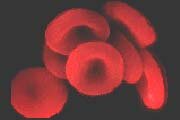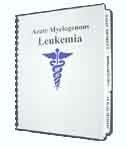 |
||
| HOME | ||
 |
||
| Acute Myelogenous Leukemia (AML) |
||
 |
||
| Other Leukemia Types (ALL / CLL / CML / HCL) |
||
 |
||
| Myelodysplastic Syndrome | ||
 |
||
| Symptoms and Diagnosis | ||
 |
||
| Leukemia Treatment Options | ||
 |
||
| " Chemotherapy | ||
 |
||
| " Blood Stem Cell Transplants | ||
 |
||
| " Radiation and Surgery | ||
 |
||
| " Chemo Side Effects | ||
 |
||
| " Clinical Trials Info | ||
 |
||
| " Coping with Leukemia | ||
 |
||
| " What to Ask Your Doctor | ||
 |
||
| Financial Assistance | ||
 |
||
| At Risk Jobs/Exposure | ||
 |
||
| Leukemia Resources | ||
 |
||
| Survivor's Story | ||
 |
||
| Leukemia News | ||
 |
||
|
Search for information:
|
||

|
Leukemia Cancer News - Return to Menu Researchers Blend Folk Treatment, High Tech For Promising Anti-cancer Compound Source: University Of Washington Death of a killer: A human leukemia cell is destroyed by artemisinin-tagged holotransferrin, a new compound engineered at the University of Washington to sneak past a cancer cell's membrane, then release an artemisinin "bomb" once inside. The new compound appears to vastly improve that deadly selectivity, according to a new study that appeared in a recent issue of the journal Life Sciences. In addition to Lai and Singh, co-authors include Tomikazu Sasaki and Archna Messay, both UW chemists. "By itself, artemisinin is about 100 times more selective in killing cancer cells as opposed to normal cells," Lai said. "In this study, the new artemisinin compound was 34,000 times more potent in killing the cancer cells as opposed to their normal cousins. So the tagging process appears to have greatly increased the potency of artemisinin's cancer-killing properties." The compound has been licensed to Chongqing Holley Holdings and Holley Pharmaceuticals, its U.S. subsidiary, to be developed for possible use in humans. Although the compound is promising, officials say, potential use for people is still years away. In the study, researchers exposed human leukemia cells and white blood cells to the compound. While the leukemia cells quickly died, the white blood cells remained essentially unharmed. The trick to the compound's effectiveness, according to Lai, appears to be in taking advantage of how cancer cells function. Because they multiply so rapidly, most cancer cells need more iron than normal cells to replicate DNA. To facilitate that, cancer cells have inlets on their surface, known as transferrin receptors, in greater numbers than other cells. Those receptors allow quick transport into the cell of transferrin, an iron-carrying protein found in blood. In creating the compound, researchers bound artemisinin to transferrin at the molecular level. The combination of the two ingredients appears to fool the cancer cell. "We call it a Trojan horse because the cancer cell recognizes transferrin as a natural, harmless protein," Lai said. "So the cell picks up the compound without knowing that a bomb artemisinin is hidden inside." Once inside the cell, the artemisinin reacts with the iron, spawning highly reactive chemicals called "free radicals." The free radicals attack other molecules and the cell membrane, breaking it apart and killing the cell. According to Lai, that process is what initially piqued his interest in artemisinin about 10 years ago. The wormwood extract was used centuries ago in China, but the treatment became lost over time. In the 1970s, it was rediscovered as part of an ancient manuscript containing medical remedies, including a recipe that used a wormwood extract. The medical community soon discovered that the extract, artemisinin, worked well against malaria, and it is currently used for that purpose throughout Asia and Africa. Artemisinin combats malaria because the malaria parasite collects high iron concentrations as it metabolizes hemoglobin in the blood. As science began to understand how artemisinin functioned, Lai said, he began to wonder if the process had implications for cancer treatment. "I started thinking that maybe we could use this knowledge to selectively target cancer cells," he said. "So far, the outlook appears good." The next step in development under the Holley licensing agreement will likely be testing in animals and, if that pans out, human trials to gauge the compound's effectiveness. The current study was funded by the Artemisinin Research Foundation and Chongqing Holley Holdings. This story has been adapted from a news release issued by University Of Washington. Related News Stories Ancient Chinese Folk Remedy May Hold Key To Non-Toxic Cancer Treatment (November 30, 2001) -- Two bioengineering researchers at the University of Washington have discovered a promising potential treatment for cancer among the ancient arts of Chinese folk medicine. Research Professor Henry Lai ... > full story Discovery Of Compound Could Enhance Cancer Treatments With Fewer Side Effects (December 28, 2004) -- The discovery of a new compound by Michigan State University researchers could lead to improved chemotherapy treatments for different types of cancers -- potentially with fewer side ... > full story Discovery Of Compound Could Enhance Cancer Treatments With Fewer Side Effects (December 24, 2004) -- The discovery of a new compound by Michigan State University researchers could lead to improved chemotherapy treatments for different types of cancers -- potentially with fewer side ... > full story
|
|
|


